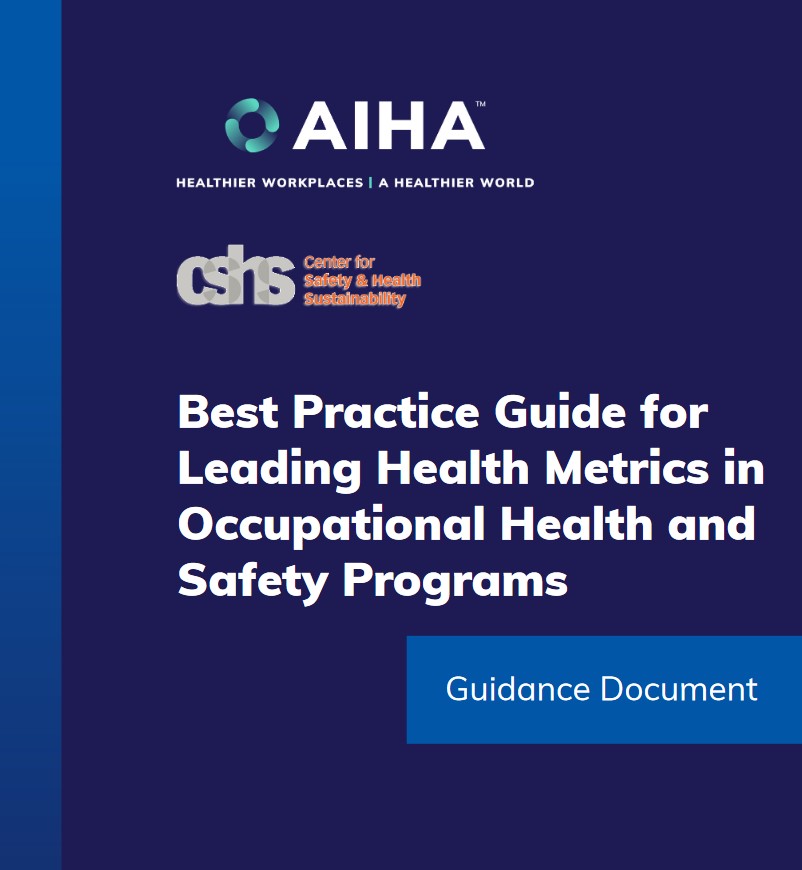by Brianna Crandall — July 9, 2021 — AIHA, the association for scientists and professionals committed to preserving and ensuring occupational and environmental health and safety (OEHS), recently announced new guidelines for developing health metrics in workplaces. The leading health metrics guidelines are designed to prevent workplace illness and injury, with an overarching goal for workers to return home as healthy as when they came to work.

The leading health metrics guidelines are designed to prevent workplace illness and injury. Image courtesy AIHA
AIHA CEO Lawrence D. Sloan, CAE, stated:
The focus on identifying measures that occur before worker’s health is harmed is critical to safeguarding worker health. AIHA hopes that these guidelines help employers create healthier workplaces and prevent occupational illness and injury in the first place.
Best Practice Guide for Leading Health Metrics in Occupational Health and Safety Programs is a guide for both practitioners and managers in the broad occupational health community, including industrial hygiene, occupational medicine, occupational health nursing, engineering, and human resources. It applies to businesses of all sizes in all industry sectors, including but not limited to manufacturing, distribution, healthcare and nongovernmental organizations.
“Leading” health metrics — as opposed to “lagging” health metrics — focus on disease prevention and health promotion, explains AIHA. They are measurable, evidence-based indicators that are used to monitor, predict, influence and manage exposures, hazards and conditions in a workplace that may impact worker health.
Health outcomes addressed by leading metrics can be acute, such as eye irritation, dermatitis, or metal fume fever — or they can be chronic, such as elevated blood pressure, hearing loss, or cancer. Leading health metrics can include the number of workers exposed to hazardous noise, the number of those who participate in tobacco cessation programs, etc.
Lagging metrics measure after-the-fact occurrences, such as injury and illness rates and prevalence of disease. Unfortunately, lagging metrics are not preventive, as worker health has already been impacted. Because of the lag time between exposure and adverse health effects, such metrics can give false reassurance when the physical manifestation from an adverse exposure is not yet present, adds AIHA.
The comprehensive guide is free and includes specific examples of leading health metrics, how to create a balanced set of leading health metrics, and how to implement and measure them in a workplace. Visit the Worker Health and Safety site to download a copy of the Best Practice Guide for Leading Health Metrics in Occupational Health and Safety Programs.
Founded in 1939, AIHA serves as a resource for Certified Industrial Hygienists and those with other professional designations employed across the public and private sectors as well as to the communities in which they work.
Covid-19-related guidelines
Readers may also be interested in some of AIHA’s Covid-19 resources, highlighted below.
AIHA recently announced recommendations designed to protect unpaid natural disaster response volunteers from COVID-19. The free Guidance to Protect Volunteers from COVID-19 During Natural Disaster Response and Recovery Guidance Document also provide volunteers with information about how volunteer organizations operate during a response to severe natural disasters including hurricanes, earthquakes, tornadoes, floods, wildfires, and more.
AIHA’s Back to Work Safely guidelines, designed for small to mid-size businesses in 27 sectors, provide recommendations on PPE; engineering controls such as ventilation, enhanced filtration, and physical barriers; enhanced cleaning and disinfection; worker personal hygiene; and physical distancing. These guidelines are available for free in both English and Spanish.
In addition to the BTWS guidelines, AIHA has free, detailed resources on engineering controls, such as:
- Guide for Recovering from COVID-19 Building Closures
- Reducing the Risk of COVID-19 Using Engineering Controls
- Employers’ Guide to COVID-19 Cleaning and Disinfection in Non-Healthcare Workplaces
- Effective and Safe Practices, Guidance for Custodians, Cleaning and Maintenance Staff
- Occupational Safety and Health Guide for Surface Disinfection Practices Using Germicidal Ultraviolet Radiation




